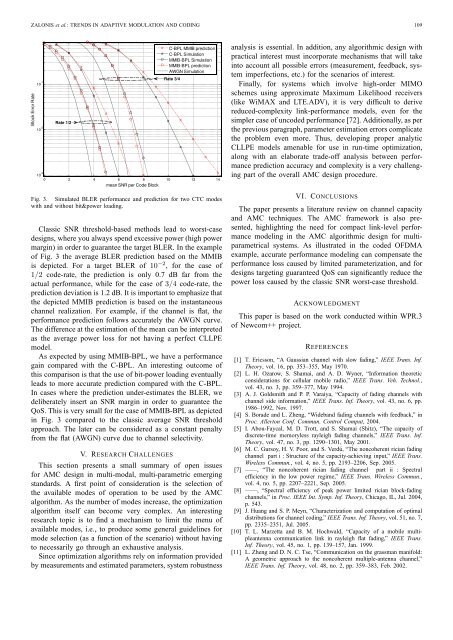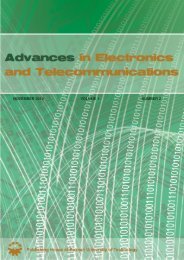channel - Advances in Electronics and Telecommunications
channel - Advances in Electronics and Telecommunications
channel - Advances in Electronics and Telecommunications
Create successful ePaper yourself
Turn your PDF publications into a flip-book with our unique Google optimized e-Paper software.
ZALONIS et al.: TRENDS IN ADAPTIVE MODULATION AND CODING 109<br />
Block Error Rate<br />
10 -1<br />
10 -2<br />
10 -3<br />
Rate 1/2<br />
C-BPL MMIB prediction<br />
C-BPL Simulation<br />
MMIB-BPL Simulation<br />
MMIB-BPL prediction<br />
AWGN Simulation<br />
Rate 3/4<br />
0 2 4 6 8 10 12 14<br />
mean SNR per Code Block<br />
Fig. 3. Simulated BLER performance <strong>and</strong> prediction for two CTC modes<br />
with <strong>and</strong> without bit&power load<strong>in</strong>g.<br />
Classic SNR threshold-based methods lead to worst-case<br />
designs, where you always spend excessive power (high power<br />
marg<strong>in</strong>) <strong>in</strong> order to guarantee the target BLER. In the example<br />
of Fig. 3 the average BLER prediction based on the MMIB<br />
is depicted. For a target BLER of 10 −2 , for the case of<br />
1/2 code-rate, the prediction is only 0.7 dB far from the<br />
actual performance, while for the case of 3/4 code-rate, the<br />
prediction deviation is 1.2 dB. It is important to emphasize that<br />
the depicted MMIB prediction is based on the <strong>in</strong>stantaneous<br />
<strong>channel</strong> realization. For example, if the <strong>channel</strong> is flat, the<br />
performance prediction follows accurately the AWGN curve.<br />
The difference at the estimation of the mean can be <strong>in</strong>terpreted<br />
as the average power loss for not hav<strong>in</strong>g a perfect CLLPE<br />
model.<br />
As expected by us<strong>in</strong>g MMIB-BPL, we have a performance<br />
ga<strong>in</strong> compared with the C-BPL. An <strong>in</strong>terest<strong>in</strong>g outcome of<br />
this comparison is that the use of bit-power load<strong>in</strong>g eventually<br />
leads to more accurate prediction compared with the C-BPL.<br />
In cases where the prediction under-estimates the BLER, we<br />
deliberately <strong>in</strong>sert an SNR marg<strong>in</strong> <strong>in</strong> order to guarantee the<br />
QoS. This is very small for the case of MMIB-BPL as depicted<br />
<strong>in</strong> Fig. 3 compared to the classic average SNR threshold<br />
approach. The later can be considered as a constant penalty<br />
from the flat (AWGN) curve due to <strong>channel</strong> selectivity.<br />
V. RESEARCH CHALLENGES<br />
This section presents a small summary of open issues<br />
for AMC design <strong>in</strong> multi-modal, multi-parametric emerg<strong>in</strong>g<br />
st<strong>and</strong>ards. A first po<strong>in</strong>t of consideration is the selection of<br />
the available modes of operation to be used by the AMC<br />
algorithm. As the number of modes <strong>in</strong>crease, the optimization<br />
algorithm itself can become very complex. An <strong>in</strong>terest<strong>in</strong>g<br />
research topic is to f<strong>in</strong>d a mechanism to limit the menu of<br />
available modes, i.e., to produce some general guidel<strong>in</strong>es for<br />
mode selection (as a function of the scenario) without hav<strong>in</strong>g<br />
to necessarily go through an exhaustive analysis.<br />
S<strong>in</strong>ce optimization algorithms rely on <strong>in</strong>formation provided<br />
by measurements <strong>and</strong> estimated parameters, system robustness<br />
analysis is essential. In addition, any algorithmic design with<br />
practical <strong>in</strong>terest must <strong>in</strong>corporate mechanisms that will take<br />
<strong>in</strong>to account all possible errors (measurement, feedback, system<br />
imperfections, etc.) for the scenarios of <strong>in</strong>terest.<br />
F<strong>in</strong>ally, for systems which <strong>in</strong>volve high-order MIMO<br />
schemes us<strong>in</strong>g approximate Maximum Likelihood receivers<br />
(like WiMAX <strong>and</strong> LTE.ADV), it is very difficult to derive<br />
reduced-complexity l<strong>in</strong>k-performance models, even for the<br />
simpler case of uncoded performance [72]. Additionally, as per<br />
the previous paragraph, parameter estimation errors complicate<br />
the problem even more. Thus, develop<strong>in</strong>g proper analytic<br />
CLLPE models amenable for use <strong>in</strong> run-time optimization,<br />
along with an elaborate trade-off analysis between performance<br />
prediction accuracy <strong>and</strong> complexity is a very challeng<strong>in</strong>g<br />
part of the overall AMC design procedure.<br />
VI. CONCLUSIONS<br />
The paper presents a literature review on <strong>channel</strong> capacity<br />
<strong>and</strong> AMC techniques. The AMC framework is also presented,<br />
highlight<strong>in</strong>g the need for compact l<strong>in</strong>k-level performance<br />
model<strong>in</strong>g <strong>in</strong> the AMC algorithmic design for multiparametrical<br />
systems. As illustrated <strong>in</strong> the coded OFDMA<br />
example, accurate performance model<strong>in</strong>g can compensate the<br />
performance loss caused by limited parameterization, <strong>and</strong> for<br />
designs target<strong>in</strong>g guaranteed QoS can significantly reduce the<br />
power loss caused by the classic SNR worst-case threshold.<br />
ACKNOWLEDGMENT<br />
This paper is based on the work conducted with<strong>in</strong> WPR.3<br />
of Newcom++ project.<br />
REFERENCES<br />
[1] T. Ericsson, “A Gaussian <strong>channel</strong> with slow fad<strong>in</strong>g,” IEEE Trans. Inf.<br />
Theory, vol. 16, pp. 353–355, May 1970.<br />
[2] L. H. Ozarow, S. Shamai, <strong>and</strong> A. D. Wyner, “Information theoretic<br />
considerations for cellular mobile radio,” IEEE Trans. Veh. Technol.,<br />
vol. 43, no. 3, pp. 359–377, May 1994.<br />
[3] A. J. Goldsmith <strong>and</strong> P. P. Varaiya, “Capacity of fad<strong>in</strong>g <strong>channel</strong>s with<br />
<strong>channel</strong> side <strong>in</strong>formation,” IEEE Trans. Inf. Theory, vol. 43, no. 6, pp.<br />
1986–1992, Nov. 1997.<br />
[4] S. Borade <strong>and</strong> L. Zheng, “Wideb<strong>and</strong> fad<strong>in</strong>g <strong>channel</strong>s with feedback,” <strong>in</strong><br />
Proc. Allerton Conf. Commun. Control Comput, 2004.<br />
[5] I. Abou-Faycal, M. D. Trott, <strong>and</strong> S. Shamai (Shitz), “The capacity of<br />
discrete-time memoryless rayleigh fad<strong>in</strong>g <strong>channel</strong>s,” IEEE Trans. Inf.<br />
Theory, vol. 47, no. 3, pp. 1290–1301, May 2001.<br />
[6] M. C. Gursoy, H. V. Poor, <strong>and</strong> S. Verdú, “The noncoherent rician fad<strong>in</strong>g<br />
<strong>channel</strong> part i : Structure of the capacity-achiev<strong>in</strong>g <strong>in</strong>put,” IEEE Trans.<br />
Wireless Commun., vol. 4, no. 5, pp. 2193–2206, Sep. 2005.<br />
[7] ——, “The noncoherent rician fad<strong>in</strong>g <strong>channel</strong> part ii : Spectral<br />
efficiency <strong>in</strong> the low power regime,” IEEE Trans. Wireless Commun.,<br />
vol. 4, no. 5, pp. 2207–2221, Sep. 2005.<br />
[8] ——, “Spectral efficiency of peak power limited rician block-fad<strong>in</strong>g<br />
<strong>channel</strong>s,” <strong>in</strong> Proc. IEEE Int. Symp. Inf. Theory, Chicago, IL, Jul. 2004,<br />
p. 543.<br />
[9] J. Huang <strong>and</strong> S. P. Meyn, “Characterization <strong>and</strong> computation of optimal<br />
distributions for <strong>channel</strong> cod<strong>in</strong>g,” IEEE Trans. Inf. Theory, vol. 51, no. 7,<br />
pp. 2335–2351, Jul. 2005.<br />
[10] T. L. Marzetta <strong>and</strong> B. M. Hochwald, “Capacity of a mobile multipleantenna<br />
communication l<strong>in</strong>k <strong>in</strong> rayleigh flat fad<strong>in</strong>g,” IEEE Trans.<br />
Inf. Theory, vol. 45, no. 1, pp. 139–157, Jan. 1999.<br />
[11] L. Zheng <strong>and</strong> D. N. C. Tse, “Communication on the grassman manifold:<br />
A geometric approach to the noncoherent multiple-antenna <strong>channel</strong>,”<br />
IEEE Trans. Inf. Theory, vol. 48, no. 2, pp. 359–383, Feb. 2002.







